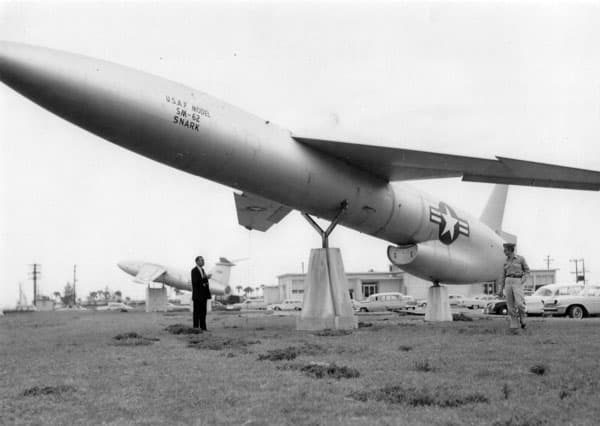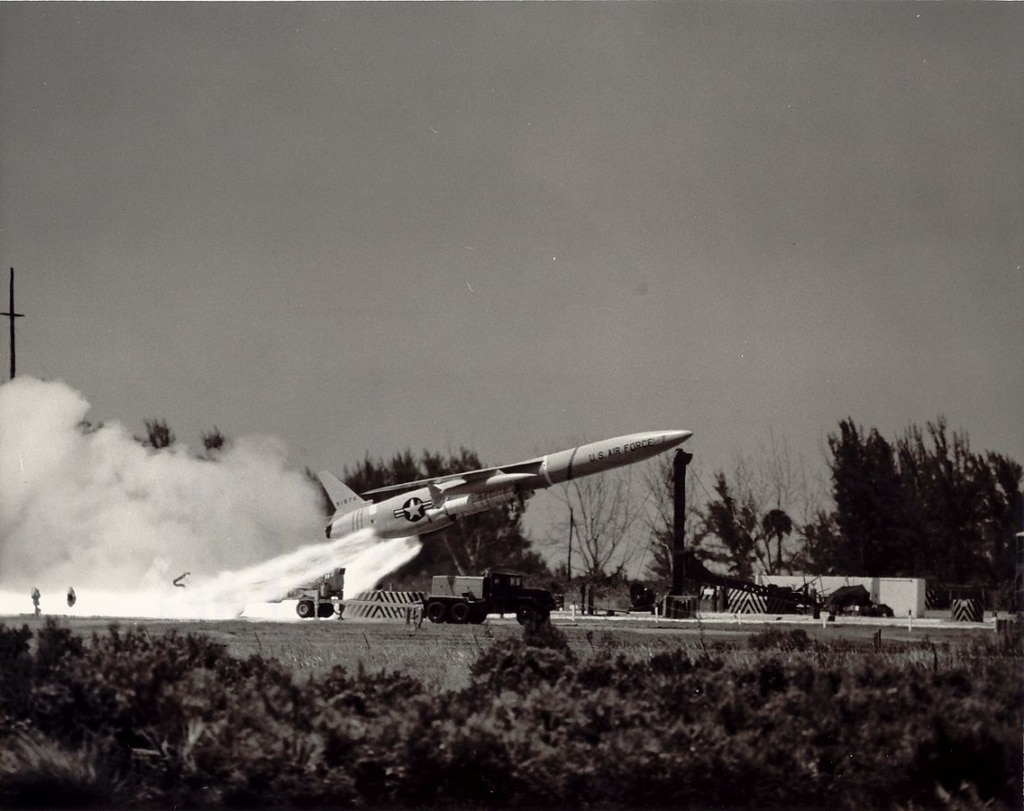The SM-62 Snark was an intercontinental, ground-launched, cruise missile developed by the United States. It was briefly in service between January 1959 and June 1961.
SM-62 Snark at a Glance
- Originated From
- United States
- Class
- Intercontinental Cruise Missile (ICCM)
- Possessed By
- United States
- Basing
- Road mobile, vehicle-launched
- Length
- 20.5 m
- Diameter
- 1.4 m
- Launch Weight
- 22,225 kg
- Propulsion
- 2 solid boosters for launch, turbojet
- Warhead
- W-39 Y1 nuclear, 3.8 mT
- Range
- 10,186 km
- Status
- Obsolete
- In Service
- 1959-1961

Snark display at the Tech Lab at Patrick Space Force Base, 21 April 1958. Photo: U.S. Air Force 
Snark missile launch. Photo: U.S. Air Force
Snark Development
In August 1945, the U.S. Air Force released a contract requirement stating its interest in a missile capable of carrying a 2,000-pound warhead roughly 5,000 miles. In January 1946, the Northrop Corporation won the contract for the first intercontinental cruise missile with a design that would come to be known as the Snark.1
By December of 1946, funding for the cruise missile was cut, but the program’s funding was renewed when Northrop promised to have the missile design and testing completed within three years at a cost of only $80,000 per missile.2 Northrop failed to deliver on that timeline, but the missile’s development continued nonetheless. Hundreds of flight tests took place between December 1950 and December 1960, with the first successful flight test occurring in April 1951.3 Despite the early successes in testing the missile, the Air Force put off production until the missile could be made more accurate. It eventually went into full production in 1958.4
As the first U.S. missile of its kind, many technologies, particularly in guidance, had to be newly developed. This made for a challenging development process, but much of the technology developed for the Snark and Navaho cruise missiles ultimately helped to inform U.S. MRBM, IRBM, and ICBM development programs later on. The Snark program, for example, was key in the development of inertial guidance systems. In the early guidance testing stages, the inertial systems were highly inaccurate, initially giving the Snark a 31.5 km CEP. In order to improve accuracy, Northrop used a combined inertial and stellar navigation system which reduced the CEP to around 8 km.5
Additionally, the guidance systems were often faulty or lost power in flight. One such incident caused a Snark flying near Puerto Rico in 1956 to go off course and eventually crash in the Brazilian rainforest where it was found by a farmer in 1983.6
Despite the original requirements calling for a missile with a range of 5,000 miles (8,056 km) and a payload of 2,000 pounds (907 kg), the Air Force made repeated changes to the contract, forcing Northrop to enhance the missile’s capabilities. This contributed to the missile’s 12-year long development and testing. By the time the Snark was deployed, it was able to deliver a 6,400 pound (2,902 kg) W-39 (3.8 Mt) nuclear warhead at ranges up to 6,329 miles (10,186 km).7 Yet despite being approved for activation, the missile was notoriously unreliable. Most of the missile’s failures were attributed to its astro-inertial guidance and control systems. Of the final 10 test flights before deployment, only a single Snark flew the target distance.8
Specifications
The Snark had a range of 10,186 km and, by the time the program ended, an accuracy of 8 km CEP, due to its combination of inertial and stellar navigation systems. This CEP put it just inside the Air Force’s requirement of 9 km CEP for the project. The missile would pitch nose-up once it reached its destination before releasing its 3.8 mT W-39 nuclear warhead.9 The missile had a flight speed of around 1,046 km/h, but later in its development, the missile was given a boost-phase that allowed it to speed up just before reaching its target, increasing its chances of penetrating enemy air defenses.10 The missile had a single stage fuselage that was 20.5 m long, 1.5 m in diameter, a wingspan of 12.9 m, and a launch weight of 22,225 kg. Unlike other missiles, the Snark was capable of returning to its base and landing, allowing the missile to be reused if its mission was cancelled mid-flight.11
Service History
The Snark had a short operational lifespan, and only saw active service with the U.S. Air Force between January 1959 and June 1961. The missile was retired by President John F. Kennedy in favor of the Atlas and Titan 1 ICBMs and the Jupiter and Thor IRBMs. During its operational period, Snarks were based at Presque Isle, Maine with the 702nd Strategic Missile Wing while Snarks undergoing testing were stationed at Patrick Air Force Base in Florida with the 556th Strategic Missile Squadron.12
Footnotes
- Kenneth Werrell, “Northrop Snark” in The Evolution of the Cruise Missile, (Montgomery, AL: Air University Press, 1985), 82.
- Ibid, 82.
- Ibid, 83.
- Ibid, 96.
- Ibid, 82-85.
- J.P. Anderson, “The Day They Lost the Snark” in Air Force Magazine, December 2004, http://www.airforcemag.com/MagazineArchive/Pages/2004/December%202004/1204snark.aspx.
- U.S. Nuclear Weapon Archive, http://nuclearweaponarchive.org/Usa/Weapons/Allbombs.html, October 14, 2006.
- Werrell, 96.
- Ibid, 89.
- Ibid, 85.
- Ibid, 89.
- Ibid, 96-97.